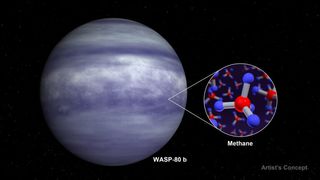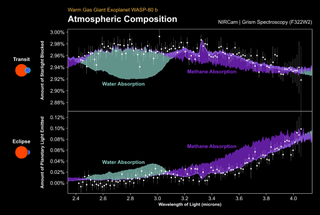James Webb Space Telescope finds water and methane in atmosphere of a 'warm Jupiter'
NASA’s powerful infrared space telescope detected the molecules as WASP-80 b orbited its parent star once every three days.

The James Webb Space Telescope (JWST) has detected methane and water vapor in the atmosphere of a Jupiter-like world located around 163 light-years away.
Astronomers made the discovery by using this powerful infrared space telescope to watch the extra-solar planet or “exoplanet” WASP-80 b pass by the face of its parent red dwarf star, which it orbits roughly once every 3 Earth days.
Astronomers have spotted water vapor in the atmospheres of around a dozen planets thus far, but the detection of methane — though commonly found in the atmospheres of solar system worlds like Jupiter, Saturn, Uranus, and Neptune — using space-based spectroscopy has been far rarer. That is what the team, including Arizona State University scientists Luis Welbanks and Michael Line of the School of Earth and Space Exploration, and Bay Area Environmental Research Institute (BAERI) researcher Taylor Bell, have now done with the James Webb Space Telescope.
"This was the first time we had seen such an obvious methane spectral feature with our eyes in a transiting exoplanet spectrum, not too much unlike what could be seen in the spectra of the solar system giant planets a half a century ago," Welbanks said in a statement.
To be clear, this isn't the first time the JWST has discovered atmospheric methane. For instance, the observatory discovered such molecules around exoplanet K12-18b earlier this year.
Related: Hubble Telescope investigates nearby exoplanet, finds it’s Earth-size
A needle in a cosmic haystack
WASP-80 b is classed as a "warm Jupiter" because it isn’t as close to its parent star as so-called hot Jupiters are, but is still closer than so-called cold Jupiters. The original Jupiter, the largest planet in our solar system and the gas giant that gives this category of planets their names, is technically a "cold Jupiter."
Get the Space.com Newsletter
Breaking space news, the latest updates on rocket launches, skywatching events and more!
Due to this relative proximity, distinguishing WASP-80 b from its red dwarf star is no mean feat. In fact, it's even the capabilities of the $10 billion JWST. It's the equivalent of spotting a single human hair from a distance of 9 miles (14.5 kilometers) away.
Fortunately, astronomers have a way to tackle the challenge. They basically wait for WASP-80 b to transit the face of the red dwarf it orbits, then observe a collective spectrum associated with the planet.
Because chemical elements and molecules absorb light at characteristic wavelengths, looking at the combined spectra and comparing it to the star’s solo spectra reveals distinctive fingerprints of specific molecules in a planet’s atmosphere.
"Using the transit method, we observed the system when the planet moved in front of its star from our perspective, causing the starlight we see to dim a bit. It’s kind of like when someone passes in front of a lamp, and the light dims," Welbanks said.
"During this time," Welbanks continued, "a thin ring of the planet's atmosphere around the planet’s day/night boundary is lit up by the star, and at certain colors of light where the molecules in the planet’s atmosphere absorb light, the atmosphere looks thicker and blocks more starlight, causing a deeper dimming compared (with) other wavelengths where the atmosphere appears transparent.
“This method helps scientists like us understand what the planet’s atmosphere is made of by seeing which colors of light are being blocked,” the researcher explained.
But the team didn't stop there. The scientists used another method to measure the atmosphere of WASP-80 b, too.

You're getting warmer… while hunting methane
Like all planets, WASP-80 b emits some of its light in the form of thermal radiation. Both the wavelength category and intensity of this light are dependent on the temperature of the planet.
This proximity of WASP-80 b to its star gives the planet a surface temperature of 1,025 degrees Fahrenheit (552 degrees Celsius.) This is in comparison to typical hot Jupiter temperatures of 2,150 degrees Fahrenheit (1,177 degrees Celsius) and the positively frigid temperatures of our Jupiter at minus 235 degrees Fahrenheit (-148 degrees Celsius).
Warm and hot Jupiters are also tidally locked to their stars, meaning they have hotter permanent "daysides" that always face the star, and permanent cooler "nightsides" that always face out into space.
Just before WASP-80 b eclipses its star, its dayside is pointed toward Earth, meaning measuring a dip in light coming from the star during the eclipse reveals infrared light coming from the planet as a result of its thermal emissions. This gives astronomers "eclipse spectra" with light absorption patterns connected to molecules in a planet’s atmosphere. These patterns sort of appear as a reduction in the planet's emitted light at specific wavelengths.
The best of both worlds
Combining the eclipse and transit data allowed the team to see how much light was both blocked and emitted by the atmosphere of WASP-80 b at different wavelengths. Then, the researchers used two different models to simulate what the atmosphere of a planet like WASP-80 b would look like under the extreme conditions of a warm Jupiter.
One model was strict, accounting for existing physics and chemistry to determine the levels of methane and water that can be expected from such a world. The other model was more flexible, trying millions of different combinations of methane and water abundances and temperatures to find the recipe that best fits the data. Comparing transit and eclipse data to both models led the team to the same, clear conclusion.
They had definitely detected methane in the atmosphere of WASP-80 b.
"Before JWST, methane had remained largely undetected, despite expectations that it could have been detected with the Hubble Space Telescope in planets where it should have been abundant," Line explained. "These lack of detections generated a flurry of ideas ranging from the intrinsic depletion of carbon to its photochemical destruction to the mixing of deep methane depleted gas."
The next step is to explore what the chemical composition of WASP-80 b can tell scientists about the exoplanet's features, formation history and evolution as they pertain to methane and water abundances. Such studies would allow the team to infer things like the ratio of atmospheric carbon to oxygen, too. This ratio is something that varies based on precisely where a planet forms around a star; it could reveal if WASP-80 b formed where it now sits, or if it was born further out before migrating toward its star.
The team will also compare the atmospheres of warm Jupiters outside the solar system to those of planets orbiting the sun, harnessing samples and data collected by space missions that have already visited Jupiter and Saturn.
"Not only is methane an important gas in tracing atmospheric composition and chemistry in giant planets but it is also hypothesized to be, in combination with oxygen, a possible signature of biology," Welbanks concluded. "One of the key goals of the Habitable Worlds Observatory, the next NASA flagship mission after JWST and Roman, is to look for gases like oxygen and methane in Earth-like planets around sun-like stars."
The team’s research was published on Nov. 22 in the journal Nature.
Join our Space Forums to keep talking space on the latest missions, night sky and more! And if you have a news tip, correction or comment, let us know at: community@space.com.

Robert Lea is a science journalist in the U.K. whose articles have been published in Physics World, New Scientist, Astronomy Magazine, All About Space, Newsweek and ZME Science. He also writes about science communication for Elsevier and the European Journal of Physics. Rob holds a bachelor of science degree in physics and astronomy from the U.K.’s Open University. Follow him on Twitter @sciencef1rst.
